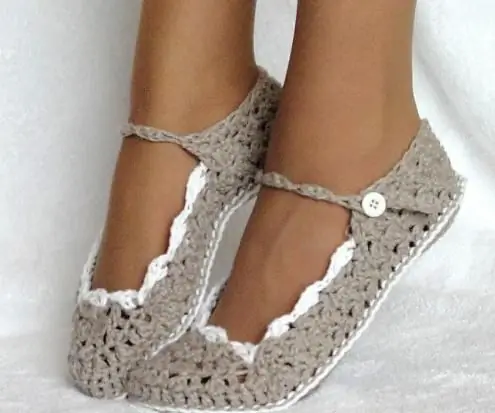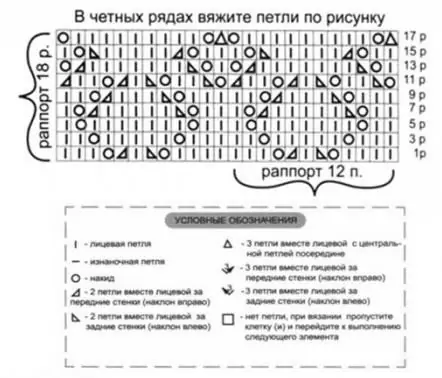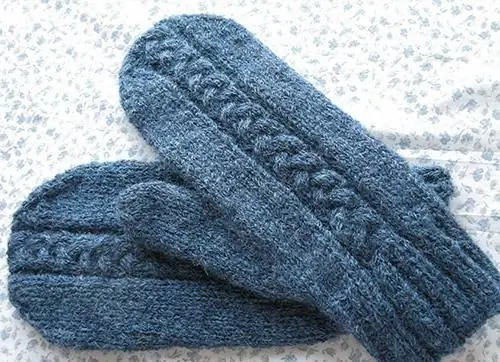
Inhaltsverzeichnis:
- Autor Sierra Becker [email protected].
- Public 2024-02-26 04:44.
- Zuletzt bearbeitet 2025-01-22 22:11.
Handgestrickte Hausschuhe schützen vor Stress und lindern Müdigkeit auf magische Weise. Gemütlich, warm und ruhig sind sie perfekt für entspannte Abende mit einem guten Buch. Mit dieser Sammlung kreativer Ideen stricken wir Hausschuhe für uns und unsere Lieben.
Anfängermodell
Für die Arbeit benötigen Sie ein Mischgarn mit mindestens 50 % Wolle, mit einer Dichte von 100 g auf 240 m und die Stricknadeln Nr. 3, 5. Auf zwei Stricknadeln stricken wir ganz einfach Hausschuhe.

Bei Größe 37-38 65 M anschlagen. Die ersten 16 Reihen werden kraus rechts gestrickt. Dies ist die zukünftige Sohle. Die nächsten 14 Reihen sind die Vorderseite. Wir stricken die mittleren drei Schlaufen so, dass sich an der Spitze ein Streifen bildet. In diesem Abschnitt machen wir Abnahmen, zwei Schleifen in jeder Reihe. Wir beenden die Arbeit mit mehreren kraus rechten Reihen und ketten ab.
Die zweiten Hausschuhe stricken wir genauso. Ferse und Sohle werden mit einer Nadel zusammengenäht, sodass eine flache Naht ohne Knoten entsteht. Wenn Sie die Teile verbindenHäkeln, die Naht wird beim Gehen zu spüren sein.
Strickpantoffeln auf zwei Nadeln
Dieses Modell ist von der Ferse bis zu den Zehen gestrickt. Bei Größe 37-38 für ein unvollständiges Bein sammeln wir 30 Schleifen. Vor dem Beginn der Finger führen wir den Stoff kraus rechts durch. Wir stricken die zehnte und zwanzigste Schleife mit Gesicht in der ersten Reihe und links auf der falschen Seite. Sie erh alten eine kleine Narbe, an der Sie das Werkstück leicht biegen können. Vom Anfang der Finger stricken wir mit einem Gummiband 1 x 1.

In der letzten Schlaufenreihe ziehen wir den Faden und ziehen ihn so fest, dass kein Loch mehr entsteht. Wir verbinden den Rücken mit einer sauberen Naht, wie auf dem Foto gezeigt. Verzieren Sie die Naht an der Spitze nach Ihren Wünschen.
Türkische Hausschuhe
Die traditionelle orientalische Art ermöglicht es Ihnen, Hausschuhe mit glatter Spitze ohne merkliche Kürzungen zu stricken. Die Arbeit beginnt von hinten. Vor dem Beginn des kleinen Fingers ist die Leinwand eben. Bei Hausschuhen der Größe 37-39 beträgt die Breite etwa 7-8 Zentimeter. Dies sind 26 Maschen auf Stricknadeln Nr. 3, 5. Die Zehe wird in kurzen Reihen gestrickt. Normalerweise sind dies drei oder vier Keile mit 14 Reihen.
In der ersten Reihe der Spitze werden 9 Maschen gestrickt, die Arbeit wird gewendet und die linke Seite wird gemacht. In der nächsten vorderen Reihe werden drei weitere Maschen gestrickt, die Arbeit wird wieder umgedreht. Somit werden durch 14 Reihen alle 26 Maschen gestrickt. Der resultierende erste Keil ändert leicht die Strickrichtung. Wenn alle Keile verbunden sind, setzt sich die Leinwand symmetrisch in die entgegengesetzte Richtung zur Ferse fort.

In der Mitte der Sohle wird eine flache Verbindungsnaht gemacht undHintergrund. Türkische Hausschuhe können auf andere Weise gestrickt werden. Dazu wird die Seite bereits zweimal gestrickt und die Maschen für die Sohle aus der Spitze rekrutiert. Beim Stricken der Sohle werden die Randmaschen des Seitenteils in jeder Reihe ausgewählt und der Pantoffel wird ohne Naht erh alten.
Japanischer Stil
Für das Modell benötigst du Garn in zwei Farben. Es kann auch unterschiedlich dick sein, das Garn für das Oberteil ist dünner und weicher, für den Hauptteil ist es eine dichte Wollmischung. Wir stricken diese Hausschuhe mit Stricknadeln Nr. 3, 5-4. 41 M für die Basis anschlagen. Mit einem Zwei-mal-Zwei-Gummiband stricken wir ein Rechteck, das lang genug ist, um den Fuß zu umwickeln. An schmalen Rippen binden wir Dreiecke mit Garn einer anderen Farbe. Dazu reduzieren wir in jeder Reihe drei Schleifen auf beiden Seiten. Wir schließen die letzten drei Schleifen.

F alten Sie das Werkstück wie auf dem Foto in zwei Hälften und verbinden Sie die Seiten. Die Spitzen der Dreiecke können mit einem Bommel, einem Knopf oder einfach angenäht werden. Hausschuhe erh alten Sie in Größe 37-38.
Hausschuhe mit Umschlag
Ein weiteres Modell im orientalischen Stil. Diese Hausschuhe werden auf zwei Nadeln gestrickt. Das Muster ähnelt dem Buchstaben T. Um die Anzahl der Anfangsschleifen zu bestimmen, müssen Sie ein Maßband an Ihren Fingerspitzen befestigen, es um Ihren Knöchel kreisen und Ihre Finger wieder erreichen.

Der erste Streifen wird kraus rechts gestrickt. Seine Breite entspricht der Breite des Fußes. Um die Sohle zu binden, werden die meisten Schlaufen an den Rändern geschlossen. Die mittleren Maschen bleiben in der Arbeit, etwa so viel wie die Anzahl der bereits gestrickten Reihen. Die Länge davonAbschnitt entspricht der Länge des Fußes. Das Werkstück wird gef altet, wobei die drei Schmalseiten mit einer linken Naht verbunden werden. Gleichzeitig kann bei den rechten und linken Hausschuhen die Richtung der F alte in eine Richtung oder in verschiedene Richtungen erfolgen. Auch die Seitennähte werden von innen nach außen geführt.
Skandinavische Traditionen
Nadelfrauen aus Norwegen und Schweden haben auch ihre eigenen originellen Techniken. Neben traditionellen Jacquardmustern zeichnen sich diese Hausschuhe durch ein besonderes Modellmuster aus. Wir stricken Hausschuhe mit Stricknadeln Nr. 3, 5-4 aus dickem Garn mit mindestens 50% Wolle.
Für den oberen Teil sammeln wir sechs Maschen auf zwei Stricknadeln und beginnen, den Zeh zu stricken. Wir fügen auf jeder Seite eine Schleife hinzu, bis 18-20 Schleifen auf den Nadeln eingegeben sind. Es sollte sich an der Breite des Fußes orientieren. Als nächstes werden etwa 20 Reihen mit einem gleichmäßigen Tuch gestrickt. Der Teil endet mit 6-8 Reihen Krausrippen. Die Sohle besteht aus einem einfacheren Jacquard. Nachdem sie die Spitze und die gewünschte Länge der Sohle (ebenfalls 20 Reihen) gestrickt haben, machen sie eine Abnahme für die Ferse.

Die Ferse kann separat gestrickt oder von der Ferse fortgesetzt werden, wobei symmetrisch Schlaufen hinzugefügt werden. Der Rücken endet mit mehreren Schalreihen, ebenso der obere Teil. Die Details sind gehäkelt. Die Naht ist außen angebracht, damit sie beim Gehen nicht zu spüren ist. Das Jacquard-Muster macht den Stoff besonders dicht und warm. Hausschuhe sind fast zweisträngig und dehnen sich fast nicht.
Turnschuhe
Um diese lustigen "Sneakers" herzustellen, benötigen Sie zweifarbiges Garn und einen Satz Nadeln. Für Größe 37-38 sammeln wir 48 Maschen und stricken Hausschuhe, beginnend mit der Zehe. Wir führen ungefähr 8-10 Reihen mit einem Gummiband 1 x 1 durch. Dann wechseln wir zu zwei Stricknadeln und arbeiten weiter mit der Hälfte der Maschen. Wir führen 40 Reihen Krausrippen durch, abwechselnd blaue und weiße Abschnitte. Der Farbwechsel erfolgt in Intarsientechnik, die Fäden kreuzen sich sauber. Auf der falschen Seite dürfen keine Räumnadeln sein. Im nächsten Abschnitt wird das Stricken in zwei Teile geteilt und bis zum Ende der Ferse fortgesetzt.

An den linken Zehenschlaufen setzen wir die Sohle fort, das Stricken ist kraus. Die Randschlaufen des Oberteils werden in jeder Reihe aufgegriffen, sodass statt einer Verbindungsnaht ein weicher Ziersaum entsteht. In den letzten 6-7 Reihen der Ferse nehmen wir um zwei Schleifen ab. Die Rückseite ist mit einem blauen Faden gehäkelt. Im oberen Teil heben wir auf beiden Seiten die Schlaufen für schmale rechteckige Teile an, in die wir die Strickspitze einfädeln. Wir sticken mit einem Kettenstich einen Zierstreifen entlang der Kante des Oberteils. Wir ziehen den Zeh mit einem Faden in zwei Ergänzungen fest und verstecken die Enden innen.
Um die Anfangsschlaufen vorsichtig abzuziehen, ist es besser, die erste Reihe mit einem Kontrastfaden zu wählen und ohne ihn zu befestigen, zu weißem Garn zu wechseln. Am Ende der Arbeit lässt sich der Kontrastfaden ganz einfach auftrennen und die weißen Schlaufen zusammenziehen.
Babyschuhe stricken
Jede der vorherigen Optionen kann in einer kleinen Größe gestrickt werden, um einem Teenager oder Kind zu entsprechen. Aber für die Kleinsten ist es besser, speziell ausgewählte Modelle zu verwenden, die gut am Bein anliegen und keine Nähte haben. Sie können zum Beispiel diese weichen Tierhausschuhe für ein einjähriges Baby herstellen.

In weichen Schuhen kann das Kind frei auf dem Boden laufen und, ohne es auszuziehen, auf Sofas und Sessel klettern. Kleine Füße werden immer warm sein. Hohe Bündchen verhindern, dass gestrickte Schuhe während aktiver Spiele von den Füßen fliegen. Die Sohle kann mit gepunktetem gummiertem Stoff angenäht werden, damit Ihr Kind nicht auf dem Boden rutscht.
Zunächst wird auf zwei Nadeln eine rechteckige Sohle gestrickt. Entlang seines Umfangs werden für den Hauptteil Schlaufen auf vier Stricknadeln gegossen und ein Rand aus Zähnen gebildet. Dazu stricken wir zwei oder drei Reihen mit Vordermasche, eine Reihe mit großen Löchern (RapportUmschlag, zwei Maschen zusammen, zwei Vordermaschen), wieder drei Reihen mit Vordermasche. Der Saum wird zur Hälfte gef altet, die Maschen der nächsten Reihe werden mit den Randmaschen der Sohle zusammengestrickt. Wieder stricken wir mehrere Reihen glatt rechts und beginnen für die Spitze mit zwei schönen Luftmaschen abzunehmen: eine Schlaufe auf jeder Seite des Fußes.

Nach acht Reihen haben die Pantoffeln die gewünschte Form. Sie können das Werkstück anprobieren, um sicherzustellen, dass das Bein frei in das linke Loch eintritt. Es bleibt eine doppelte Manschette zu binden. Ab der Stelle, an der der Falz vorgesehen ist, muss die Vorderfläche auf die falsche Seite geändert werden. Auf der gebogenen Seite ist dann wieder die Vorderfläche sichtbar. Es wird nicht schwer sein, ein Kindermodell nach dem Geschmack des Kindes mit allerlei Augen und Ohren zu gest alten.
Zephyr-Booties
Hausschuhe für Babys bis zu sechs Monaten sollten etwas Besonderes sein. Kinder laufen noch nicht in diesen Schuhen. Die sogenannten Booties werden benötigt, um die Beine vor Kälte zu schützen und das Baby an das Gefühl von Schuhen an den Füßen zu gewöhnen. Die Originalmodelle sind oftfür spektakuläre Fotoshootings verwendet.
Strickpantoffeln mit runder Spitze, ähnlich einem Stück Marshmallow. Das Modell wird auf zwei Stricknadeln von der Ferse bis zur Spitze und zurück gefertigt. Wir machen ein Rechteck aus 26 Maschen und 61 Reihen kraus rechts. Wir schließen die extremen 8 Schleifen. Als nächstes abwechselnd die weißen Streifen der Vorderseite und die blauen Streifen der falschen Seite. Es gibt 12 Streifen, insgesamt 4 Reihen. Von der Kante sammeln wir 8 Maschen und stricken das zweite Rechteck kraus rechts. Wir ziehen den Zeh auf beiden Seiten fest. Absatz und Sohle verbinden wir mit einer Flachnaht ohne Knoten.

Es ist wichtig, dass die ersten Schuhe sicher sind. Das Kind wird es sorgfältig studieren und es auf jeden Fall am Zahn ausprobieren. Lassen Sie sich daher nicht davon hinreißen, dekorative Knöpfe und Perlen aufzunähen. Es reicht aus, um die Stiefeletten hell und angenehm anzufassen.
Empfohlen:
Stricken aus Mohair mit Stricknadeln. Stricknadeln: Schemata. Wir stricken aus Mohair

Das Stricken aus Mohair mit Stricknadeln bereitet den Näherinnen eine wahre Freude, das Ergebnis sind leichte, schöne Dinge. Leser können sich in diesem Artikel über die Eigenschaften dieses Threads und die Funktionen für die Arbeit damit informieren. Auch hier sind Beschreibungen der Ausführung von Mohair-Kleidungsstücken und Fotos von fertigen Produkten. Wenn sie sich auf sie konzentrieren, können Handwerkerinnen schöne warme Outfits für sich und ihre Lieben stricken
Wir stricken modische Leggings mit Stricknadeln

Modische Strickleggings sind längst keine Sportbekleidung mehr, sondern ein unverzichtbares Accessoire über Stiefeln und Stiefeletten mit Absatz. Sie sind wahrscheinlich auf durchbrochene oder geprägte Modelle gestoßen, die die klassischen einfarbigen und gestreiften Leggings ersetzt haben. Sie können sie nach einem einfachen Muster stricken, es reicht aus, das Prinzip selbst zu verstehen
Wir stricken einen Schalkragen mit Stricknadeln

Der Kragenschal erfreut sich nicht nur als warmes und praktisches Kleidungsstück großer Beliebtheit, sondern auch als originelles Accessoire, das sportlichen und klassischen Outfits Schwung verleiht
Wir stricken Fäustlinge mit Stricknadeln - wir schaffen Schönheit mit Mustern oder mit einem Muster

Fäustlinge sind im Gegensatz zu so großen Dingen wie Pullovern, Kleidern, Pullovern viel schneller gestrickt und es wird weniger Wolle benötigt. Diese kleinen Produkte können jedoch sehr schön gemacht werden, wenn man in sie Fantasie und ein wenig Ausdauer investiert. Wir stricken Fäustlinge mit Stricknadeln und tragen sie dann gerne
Wir stricken eine Mütze mit Stricknadeln: Modelle, Fotos, Stellenbeschreibung

Jeder Mensch träumt davon, schön und stilvoll auszusehen. Sehr oft gibt es jedoch keinen passenden Artikel im Sortiment des Geschäfts. Und dann musst du es selber machen. In diesem Artikel werden wir beispielsweise darauf achten, wie man eine Mütze strickt
